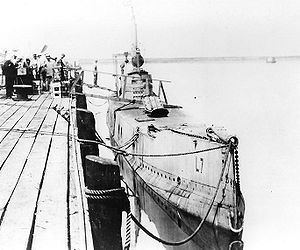Name USS L-7 Commissioned 7 December 1917 Construction started 2 June 1914 Length 50 m Builder Long Beach | Laid down 2 June 1914 Decommissioned 15 November 1922 Launched 28 September 1916 Test depth 61 m | |
 | ||
Fate Sold for scrapping, 21 December 1925 Displacement 451 long tons (458 t) surfaced
527 long tons (535 t) submerged | ||
USS L-7 (SS-46) was an L-class submarine built for the United States Navy during the 1910s.
Contents
Description
The L-class boats designed by Lake Torpedo Boat (L-5 through L-8) were built to slightly different specifications from the other L boats, which were designed by Electric Boat, and are sometimes considered a separate L-5 class. The Lake boats had a length of 165 feet (50.3 m) overall, a beam of 14 feet 9 inches (4.5 m) and a mean draft of 13 feet 3 inches (4.0 m). They displaced 451 long tons (458 t) on the surface and 527 long tons (535 t) submerged. The L-class submarines had a crew of 28 officers and enlisted men. They had a diving depth of 200 feet (61.0 m).
For surface running, the boats were powered by two 600-brake-horsepower (447 kW) diesel engines, each driving one propeller shaft. When submerged each propeller was driven by a 400-horsepower (298 kW) electric motor. They could reach 14 knots (26 km/h; 16 mph) on the surface and 10.5 knots (19.4 km/h; 12.1 mph) underwater. On the surface, the Lake boats had a range of 5,150 nautical miles (9,540 km; 5,930 mi) at 11 knots (20 km/h; 13 mph) and 150 nmi (280 km; 170 mi) at 5 knots (9.3 km/h; 5.8 mph) submerged.
The boats were armed with four 18-inch (45 cm) torpedo tubes in the bow. They carried four reloads, for a total of eight torpedoes. The L-class submarines were also armed with a single 3"/50 caliber deck gun.
Construction and career
L-7's keel was laid down on 2 June 1914 by Craig Shipbuilding Company in Long Beach, California. L-7 was launched on 28 September 1916 sponsored by Mrs. William B. Forgarty, and commissioned on 7 December 1917 with Lieutenant P. M. Bates in command. After shakedown, L-7 departed the West Coast on 20 April 1918, arriving Charleston, South Carolina, on 10 June. Patrolling off Charleston until 15 October, the submarine finally steamed for the waters of Europe to battle the U-boats. Arriving Ponta Delgada, Azores, early in November, she joined Submarine Division 6 for anti-submarine warfare operations. However, the Armistice with Germany of 11 November 1918 ended World War I, and L-7 sailed for home on 19 November.
Following stops at Caribbean Sea and Central American ports, the submarine arrived San Pedro, California, on 14 February 1919, completing one of the best long distance seagoing performances of America's youthful submarine force. From 1919 to 1922, she remained on the West Coast, experimenting with new torpedoes and undersea detection equipment. After a period of commission in ordinary early in 1922, L-7 was returned to full commission on 1 July and sailed for Hampton Roads, Virginia, the same month. She decommissioned there on 15 November 1922 and was sold on 21 December 1925 to M. Samuel and Sons for scrapping.
